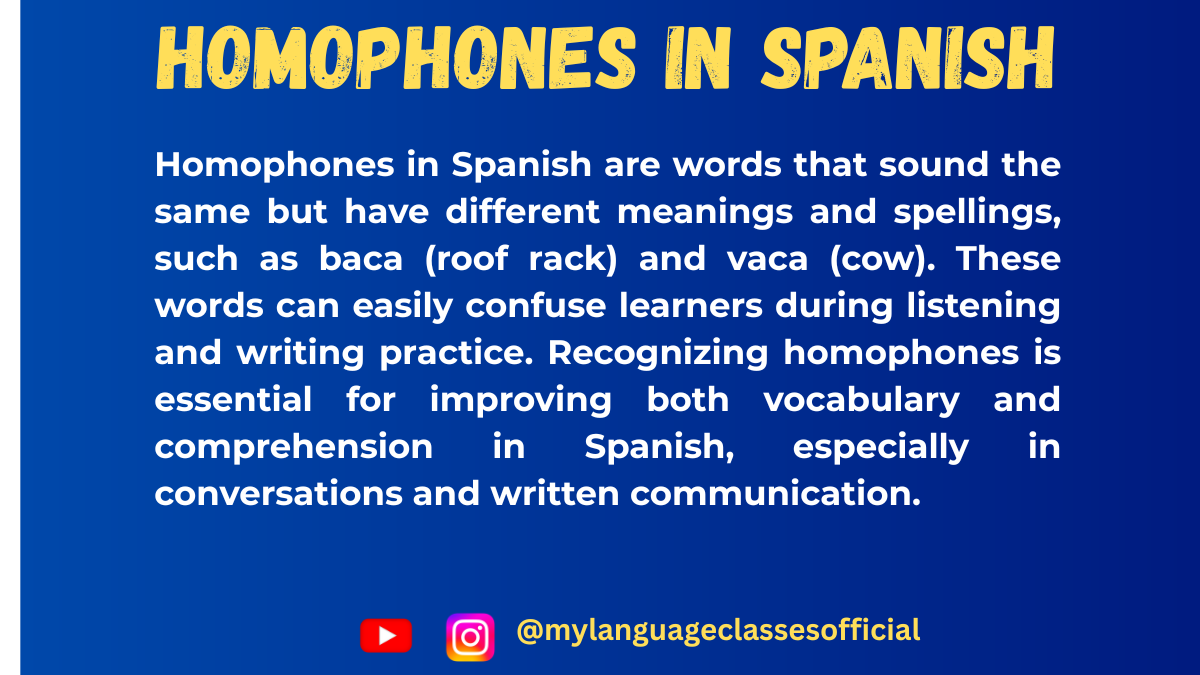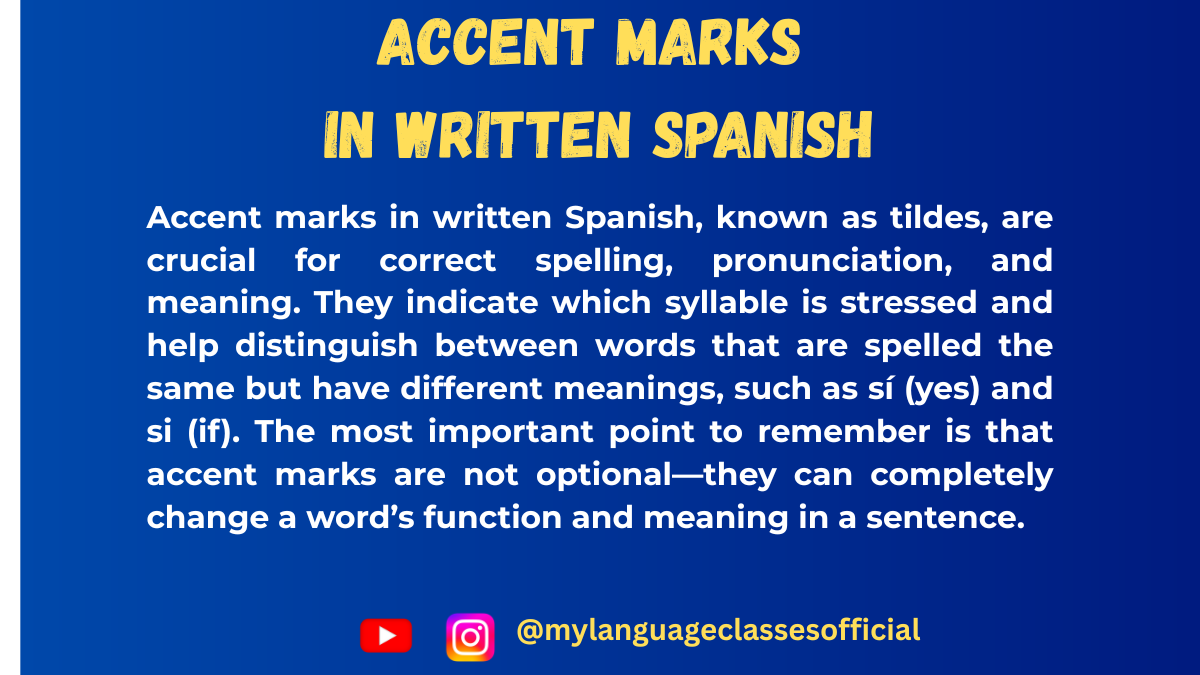Your cart is currently empty!
Tag: Spanish spelling rules
-

Differentiating Homophones in Spanish: Tú vs. Tu, Él vs. El, and Others
What Are Homophones?
Homophones are words that sound the same but have different meanings and spellings. In Spanish, many homophones exist due to the presence or absence of accent marks (tildes), which change the meaning of a word entirely. Understanding these differences is crucial for mastering Spanish grammar and avoiding misunderstandings in writing and speech.
Common Homophones in Spanish
Below is a list of frequently confused homophones in Spanish, along with their meanings and example sentences.
Homophones Meaning 1 Meaning 2 Example Sentence 1 Example Sentence 2 Tú / Tu (Pronoun) You (Possessive adjective) Your Tú eres muy simpático. (You are very nice.) Tu casa es grande. (Your house is big.) Él / El (Pronoun) He (Article) The Él es mi hermano. (He is my brother.) El coche es rojo. (The car is red.) Más / Mas (Adverb) More (Conjunction) But Quiero más comida. (I want more food.) Quise ir, mas no pude. (I wanted to go, but I couldn’t.) Sí / Si (Adverb) Yes (Conjunction) If Sí, quiero ir. (Yes, I want to go.) Si tienes tiempo, llámame. (If you have time, call me.) Dé / De (Verb) Give (subjunctive) (Preposition) Of, from Quiero que me dé la llave. (I want him to give me the key.) La casa de mi madre es grande. (My mother’s house is big.) Té / Te (Noun) Tea (Pronoun) You (object) Me gusta el té verde. (I like green tea.) Te quiero mucho. (I love you very much.) Aún / Aun (Adverb) Still, yet (Adverb) Even Aún no he terminado. (I haven’t finished yet.) Aun los niños pueden hacerlo. (Even the children can do it.) Solo / Sólo (Adjective) Alone (Adverb) Only (obsolete accent) Me siento solo. (I feel alone.) Sólo quiero una respuesta. (I only want an answer.) Porque / Por qué (Conjunction) Because (Interrogative phrase) Why No fui porque estaba enfermo. (I didn’t go because I was sick.) ¿Por qué estás triste? (Why are you sad?) Qué / Que (Interrogative) What (Conjunction) That ¿Qué quieres? (What do you want?) Dijo que vendría mañana. (He said that he would come tomorrow.)
More Example Sentences
- Tú puedes venir, pero tu hermano no. (You can come, but your brother can’t.)
- Él dijo que el problema está resuelto. (He said that the problem is solved.)
- Quiero más, mas ya no hay comida. (I want more, but there’s no food left.)
- Sí voy a la fiesta, pero si tú vas también. (Yes, I will go to the party, but only if you go too.)
- Es importante que me dé una oportunidad para explicar de qué hablo. (It’s important that he gives me a chance to explain what I’m talking about.)
- Té caliente o frío, como prefieras, pero te recomiendo el de menta. (Hot or cold tea, as you prefer, but I recommend the mint one.)
- Aún estás aquí? No puedo creer que aun después de todo no te hayas ido. (Are you still here? I can’t believe that even after everything, you haven’t left.)
- Está solo en casa, pero sólo hasta las cinco. (He is alone at home, but only until five.)
- No entiendo por qué estás tan cansado, porque dormiste bien. (I don’t understand why you’re so tired, because you slept well.)
- Qué bonito día! No sabía que te gustaba la primavera. (What a beautiful day! I didn’t know that you liked spring.)
Things to Keep in Mind
- Accent marks matter: In Spanish, accents are not optional; they change the meaning of words entirely.
- Articles and gender: Be mindful of definite articles (el, la, los, las) and their relation to nouns.
- Pronouns vs. adjectives/articles: Many homophones differ between being pronouns and adjectives/articles (e.g., tú vs. tu).
- Conjunctions and adverbs: Words like mas and más or aún and aun play different grammatical roles.
Fill in the Blanks
- No sé _______ hacer. (Qué / Que)
- No quiero _______ me hables así. (que / qué)
- _______ tiempo hace hoy? (Qué / Que)
- Me gusta _______ café de tu casa. (el / él)
- _______ quiere ir al cine. (El / él)
- Tienes que _______ las gracias. (dé / de)
- Todavía no lo he visto. Está _______ ocupado. (aún / aun)
- Prefiero tomar _______ en la mañana. (té / te)
- Me gusta mucho _______ casa. (tu / tú)
- _______ es muy simpática. (Tú / Tu)
Answers:
- Qué 2. que 3. Qué 4. el 5. él 6. dé 7. aún 8. té 9. tu 10. Tú
Conclusion
Mastering Spanish homophones is essential for both speaking and writing correctly. Paying attention to accent marks, sentence context, and grammatical functions will help avoid misunderstandings. Keep practicing, and soon differentiating these words will become second nature!
Thank you for reading this comprehensive guide.
To keep improving your Spanish skills and exploring more language tips, please:
- Visit: mylanguageclassesblog.wordpress.com
- Follow on Instagram: My Language Clases
- Subscribe on YouTube: My Language Classes Channel
Stay curious, keep practicing, and enjoy your language learning journey!
- 100 Spanish Example Sentences
- 100 Spanish Fill-in-the-Blanks Exercises
- 100 Spanish Vocabulary Lists
- Spanish – Advanced
- Spanish – Beginner
- Spanish – Intermediate
-

Correct Use of Accent Marks in Written Spanish
Spanish is a phonetic language, meaning words are pronounced as they are written. However, the correct use of accent marks (tildes) is crucial to ensuring clarity and avoiding misunderstandings. Accent marks in Spanish are not just decorative; they indicate stress and, in some cases, distinguish words that are otherwise spelled the same but have different meanings. Let’s explore how to use accent marks correctly and why they are so important.
The Importance of Accent Marks in Written Spanish
Accent marks can completely change the meaning of a word. For example:
- tú (you) vs. tu (your)
- Tú tienes un coche nuevo. (You have a new car.)
- Tu coche es nuevo. (Your car is new.)
- sí (yes) vs. si (if)
- Sí, quiero ir al cine. (Yes, I want to go to the movies.)
- Si quieres, podemos ir al cine. (If you want, we can go to the movies.)
- más (more) vs. mas (but)
- Quiero más azúcar en mi café. (I want more sugar in my coffee.)
- Quería ir, mas no pude. (I wanted to go, but I couldn’t.)
As you can see, missing an accent mark or placing one where it doesn’t belong can lead to confusion and change the meaning of a sentence entirely.
Rules for Using Accent Marks in Spanish
1. Words That Follow Natural Stress Rules (No Accent Mark Needed)
Spanish words naturally follow two stress rules:
- If a word ends in a vowel, ‘n’, or ‘s’, the stress falls on the second-to-last syllable.
- Example: casa (house), lápices (pencils), comen (they eat)
- If a word ends in any other consonant (except ‘n’ or ‘s’), the stress falls on the last syllable.
- Example: hotel (hotel), reloj (watch)
When words do not follow these natural stress rules, an accent mark is needed.
2. Words That Break the Natural Stress Rules (Require an Accent Mark)
- Example: canción (song), teléfono (telephone), inglés (English)
3. Differentiating Homonyms (Diacritical Marks)
Certain words have the same spelling but different meanings, distinguished by an accent mark:
- tú (you) vs. tu (your)
- sí (yes) vs. si (if)
- éste (this one) vs. este (this)
- qué (what) vs. que (that)
Example Sentences:
- ¿Qué quieres hacer? (What do you want to do?)
- Dijo que vendría. (He said that he would come.)
4. Interrogative and Exclamatory Words Need an Accent
Question words always have an accent mark:
- ¿Cómo te llamas? (What’s your name?)
- ¡Qué sorpresa! (What a surprise!)
5. Monosyllabic Words Usually Do Not Carry an Accent
Single-syllable words generally do not take an accent, except when distinguishing homonyms:
- tú (you) vs. tu (your)
- mí (me) vs. mi (my)
6. Accent Marks in Verb Forms
Verbs in the preterite and commands often require accents:
- está (he/she/it is) vs. esta (this)
- dé (give) vs. de (of, from)
Things to Keep in Mind
- Accent marks are essential and can change the meaning of a word completely.
- Follow natural stress rules and apply accents when needed.
- Learn and memorize common homonyms with accents.
- Question words always require an accent.
- Verb forms often require accents to maintain clarity.
Fill in the Blanks
- ___ (Tu/Tú) eres muy amable.
- No sé ___ (si/sí) puedo ir mañana.
- Me gusta este libro, pero prefiero ___ (aquel/aquél).
- No entiendo qué quiere decir ___ (mas/más).
- Voy a comprar ___ (mi/mí) coche nuevo.
- ¿___ (Que/Qué) hora es?
- Espero que Juan me ___ (dé/de) un consejo.
- No sé si ella está aquí ___ (aun/aún).
- ¿Te gusta el ___ (café/cafe)?
- Mi hermano siempre ___ (está/esta) ocupado.
Answers
- Tú eres muy amable.
- No sé si puedo ir mañana.
- Me gusta este libro, pero prefiero aquel.
- No entiendo qué quiere decir más.
- Voy a comprar mi coche nuevo.
- ¿Qué hora es?
- Espero que Juan me dé un consejo.
- No sé si ella está aquí aún.
- ¿Te gusta el café?
- Mi hermano siempre está ocupado.
Conclusion
Mastering accent marks in Spanish is essential for clear communication. A missing or misplaced accent can change the meaning of a word completely and lead to confusion. By understanding the rules and practicing regularly, you can improve your written Spanish and avoid common mistakes. Always double-check accent marks, especially in homonyms and verbs, to ensure your writing is accurate and professional. ¡Buena suerte!
If you enjoyed this lesson, be sure to check out more posts like this on my blog at My Language Classes. Don’t forget to subscribe my YouTube channel and follow me on Instagram for the latest language learning tips and lessons. Leave a comment below to share your thoughts, or ask any questions you have.
Happy learning! 😊
- tú (you) vs. tu (your)
